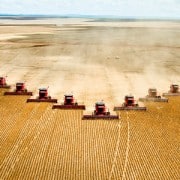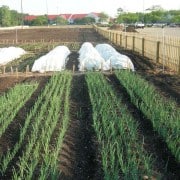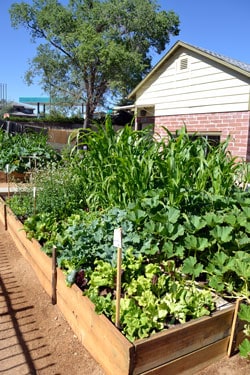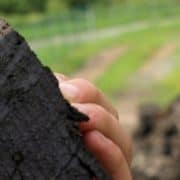Terra Preta- Magic Soil of the Lost Amazon Part II
What is the Best Way to Build the Health and Resiliency of my Garden Soil?
Welcome to the second part of Terra Preta, or how using Stone Age agricultural techniques may just be the best way to build the health, fertility, resiliency and nutrient cycling of the soil several fold. We will start with the second part of the article from Acres USA, which is a Q and A session, then will look at several points to consider.
The photo is of a section of Terra Preta that is being studied by Dr. Etelvino Novotny of Brazil, a PhD in Physical Chemistry with a Masters in Soil Science. You can see the depth of the Terra Preta!
Terra Preta Q&A
Why did production of terra preta stop after European contact?
Although the decimation of the Amazonian population and the collapse of the elaborate social systems that supported terra preta creation (to make all that pottery and to make all that charcoal and incorporate it up to 2 feet in the ground really does take a village) was a contributing factor, it was undoubtedly the introduction of the steel axe by the Spanish that, in combination with the impact of contact, led to slash-and-burn by small bands replacing slash-and-char by large groups. When clearing land with a stone axe, a conservation of all biomas and an intensification of soil production becomes a necessity. Steel axes – and, later, chainsaws – contributed to exploiting the very short-term benefits of ash. It must be remembered that traditional methods can die out in a single generation, and that in Amazonian social structure, the elders were responsible for all technical knowledge. It makes sense that the elders were the hardest hit by epidemics, and the loss of their cultural knowledge combined with social disruption would lead to the replacement of a deeply effective technology with an less-effective mimicry.
Did natives use special microbial brews to inoculate the soil to create terra preta?
There is no proof that a “mother” culture was used for starting terra preta. Current research indicates that the incorporation of charcoal of certain qualities (created in relatively low heat, for example) in combination with appropriate initial fertilization (often, in university tests, with conventional fertilizers that are damaging to soil life) will produce a substantial increase in yields. It is assumed that the char provides such an effective habitat for microbes that effective communities will rapidly develop within most soils. What we don’t know yet is whether the simulated terra preta will have the ability to maintain its fertility for as long as the ancient form.
Has terra preta been discovered outside of the Amazon?
Yes, high-carbon terra preta-like dark soils have been discovered in Holland, Japan, South Africa and Indonesia and are currently being studied.
Can carbon inputs other than charcoal be used?
The Japanese are extensively investigating the use of coal dust for promoting field fertility. Coal dust does seem to reproduce many of the positive effects of wood charcoal. The research of Siegfried Marian on the benefits of carbon incorporation, as reported in Leonard Ridzon and Charles Walters’ The Carbon Connection and The Carbon Cycle, led to the development of Ridzon’s NutriCarb product (no longer being produced), which claimed agricultural benefits very similar to those claimed for terra preta . Those who want to use coal dust for soil fertility need to make certain that the dust is from brown coal, which is more humic, and that the coal does not contain toxins.
Why is terra preta often linked to alternative energy and climate change?
Terra preta is a carbon sink, as is most carbon in the soil. Slash-and-burn agriculture contributes greatly to global warming. If terra preta technologies were applied to tropical farming, less land would have to be cleared for farming, and if farmers in temperate zones such as the Midwest incorporated charcoal or other chars into their soil, more carbon could be sequestered. If this char is produced by appropriate technology, such as pyrolysis, both fuel and a “restorative, high-carbon fertilizer” can be produced. This process does not require wood – it is just as effective when agricultural wastes, such as peanut shells, are used as input. A good place to learn about this technology is at www.eprida.com.
How much charcoal needs to be incorporated?
In published reports on pot tests of the effect of charcoal on plant growth, incorporation at 20-30 percent by weight tended to consistently produce the most benefit. In row crops, this would translate to 30 percent by weight of the top 6 inches.
Are there benefits for plant health from terra preta ?
Better plant growth and health is evident with the use of native terra preta. Current investigations are primarily being conducted by archaeologists, geologists and soil scientists. There is no evidence of terra preta studies by an agriculturist, but positive reports from growers suggest that eco-farmers would be well advised to investigate terra preta technology.
Allan Balliett is a biodynamic farmer and educator who operates a CSA serving families in the Washington, D.C. metro area. He is the founder and moderator of BD Now!, the international progressive biodynamic food and farming discussion listserve. He can be reached at Fresh and Local CSA, P.O. Box 3047, Shepherdstown, West Virginia 25443, phone 304-876-3382, email allan@FreshAndLocalCSA.com, website www.freshandlocalcsa.com.
This ends the article from Acres USA.
It is interesting to note that of all the research and reading that I have done, most of the knowledge is indeed from the University research departments. Some are archeological based, others are looking at the carbon sequestering elements of charcoal or bio-char, and more than a few are interested in the continual fertility and regeneration of the soils once they have had charcoal incorporated into them.There are very few resources devoted to the thought of how to incorporate charcoal into gardening and current agricultural practices.
The following is from a Biochar Discussion List–
The following benefits occur with additions of biochar to the soil, in amounts ranging from 3 oz. per square foot up to 16 oz. per square foot-
- Enhanced plant growth
- Suppressed methane emission
- Reduced nitrous oxide emission (estimate 50%)
- Reduced fertilizer requirement (estimate 10%)
- Reduced leaching of nutrients
- Stored carbon in a long term stable sink
- Reduces soil acidity: raises soil pH
- Reduces aluminum toxicity
- Increased soil aggregation due to increased fungal hyphae
- Improved soil water handling characteristics
- Increased soil levels of available Ca, Mg, P, and K
- Increased soil microbial respiration
- Increased soil microbial biomass
- Stimulated symbiotic nitrogen fixation in legumes
- Increased arbuscular mycorrhyzal fungi
- Increased cation exchange capacity
Sounds pretty impressive, doesn’t it? There are many pages of discussions on the positive impacts of charcoal or biochar, what is the best method of making biochar, how much to add to the soil, etc. and etc. It is easy to read oneself blind. It is wonderful to see so much attention devoted to studying the benefits of charcoal and how it interacts with the soil. The home gardener, however, is usually more concerned with how to incorporate an idea into their garden than reading all of the latest research. Let’s face it, sequestering carbon, qualifying for carbon credits, and reducing greenhouse gases for the home gardener is a smaller interest than the increased soil fertility, nutrient cycling, nitrogen fixing and improving plant growth, health and productivity that charcoal provides.
What we do know is this-
- Charcoal is created by burning wood or similar materials in an oxygen free environment. Charcoal is not ash that comes out of your wood burning stove.
- The addition of charcoal to soil has profoundly positive effects that are extensive and long lasting. By some estimates the lifespan of charcoal in soil is in excess of 1,600 years.
- The amount needed is quite small- from 3 oz. per square foot to an upper limit of 16 oz. per square foot.
- There is a definite, noticeable period of productivity lag after adding charcoal directly to the soil.
- Charcoal needs to be “charged” or “activated” with minerals and trace elements prior to it being able to contribute to soil fertility. The best way to do this is in compost, preferably a manure-based compost that already has minerals and trace elements.
- Adding a mineral and trace element rich supplement to the charcoal/compost greatly increases the nutrient cycling and “activation” of the charcoal
- The time period needed to “charge” the charcoal is at least six months, preferably a year.
- Soon after adding charcoal to compost, the fungal, microbial and earthworm activity drastically increases.
- Adding charcoal to compost speeds up the decomposition by several times.
- The ideal size for the charcoal chunks is between the size of rice and corn.
So how, exactly, does one go about incorporating charcoal into the garden? Charcoal is relatively easy to find. Lowe’s or Home Depot have it in the grill section. Look for “Lump” or “Hardwood” charcoal. Stay away from briquets, as they are pressed and formed out of much more than plain charcoal. They usually have chemical or petroleum fire-starting compounds in them along with fillers. Come to think of it, you probably don’t want to be cooking with them, either, as you don’t want the fillers and fire-starters on your burgers! Right now a 8.8 Lb bag is $6.99 locally. Sam’s Club has 40 Lb bags of mesquite charcoal for $17.00 in the spring and summer. It will look just like a burned log or branch. Once you get your charcoal, it needs to be broken or crushed to smaller pieces. The optimum size is between a grain of rice and a kernel of corn. Be aware of the dust created from crushing the charcoal, as you don’t want to breathe it. The dust is fine for the compost pile. To crush it, you need to get creative. I have cut an old propane tank in half to make an industrial pestle and mortar, but a 3 Lb drilling hammer or hand sledge hammer on a piece of concrete will do just fine. A rock will do just fine. Remember, this is Stone Age technology here, so don’t over-think or over-complicate it! You want to create crushed charcoal with what tools and materials you have available. Once it is crushed, add it to the compost pile or bin. Make sure to mix it in so it will make the most contact possible with the compost. A very good technique is to crush a little each time you add to the compost. This mixes the charcoal evenly.
After incorporating charcoal into your compost, make sure it has sufficient moisture and let it do it’s magic for the next 6 months. You should see microbial, fungal and earthworm activity starting in about a month, along with an accelerated breakdown of the compost. At the end of the 6 months, it should resemble rich, humic soil that is full of life! Then you feed the garden soil with a top layer of about 2 inches in the fall and spring and watch everything in your garden grow like crazy.
Our next installment on building your garden soil will focus on the mineralization aspect, or how to get a sufficient amount of minerals into your soil without having to lug around endless bags of soil amendments! It ties in closely with the charcoal and compost, so stay tuned…










Be careful purchasing charcoal. Some brands come from Brazil, most likely Amazonian in origin, which has deforestation and global transport carbon fingerprints. Kingsford briquettes (for example) include coal, so read the labels, act as ethically as you can. Producing your own has pollution consequences. If you find a source you can live with, try crushing it in the largest meat grinder you can find, with the smallest plate holes available. Charcoal is partially combusted wood, meaning the sappy chemicals (volatiles)have been burned off, leaving the elemental charcoal, which preserves much of the wood structure, hence the hugely porous form that provide microbes with living quarters and compartments for nutrient exchange. This means that if you produce your own charcoal, you leave behind some of the heating value of the wood. Utilizing these volatile gases as a fuel requires another step (like an internal combustion engine or a combustion turbine). Wood gasifiers powering vehicles are an example of this process. This all gets pretty complicated in a modern setting compared to smoldering (and unhealthy) fires probably used by Native Peoples. There are companies trying to build and operate gasifiers on a commercial level to produce energy and charcoal as a soil amendment. It’s very hard to do as an economically viable commercial enterprise.
You make a good point in being careful what charcoal you buy, as I point out in the article- don’t buy briquettes as they contain fire starting chemicals, petroleum distillates and fillers. Buy “lump” or “hardwood” charcoal. Most of the time it is easy to read on the bag where the charcoal comes from. Lots comes from Mexico and is Mesquite in origin.
Making your own can be done, but is much more time involved and difficult than buying a bag.
We recently moved and now I cannot wait to get my compost bin into use.
This information sounds exciting, so I am anxious to try it.
http://myrasaidit.blogspot.com
Visit me here to learn about GMOs, Pesticides, and Insecticides.
Thanks for the wonderful articles. I’m definitely going to do the compost pile. New to Organic Gardening – 3 years now.
Cindy-
That’s great about the compost pile! Just don’t overthink it or overcomplicate it. It can and should be simple. Add your kitchen scraps that are non-meat, your grass clippings, leaves from raking, etc. and you’ll build a wonderfully nutritious garden amendment soon. It is best if you can have some animal manure as a base, but not required. Horse and cow are the most common.
Myra-
Stay tuned, as the next installment will be up soon- how and why to mineralize or re-mineralize your soil and the benefits it will bring you.
I make my own charcoal, I live on 8 acres of woods. I take anything that will not pass through a 2″ screen and use in my grill or fireplace. Upon rescreening through 1″ anything that won’t pass gets sent through the wood chipper, strategically placed to send charcoal dust towards my mushroom beds. The resulting size is roughly dust to corn kernel size and straight to the garden it goes.
Hadn’t thought of using a wood chipper for that, but it sounds like it will do the trick! Thanks for sharing this Jeremy.
I make charcoal and the crushing of it is easy.
Put the charcoal in a grain/sand bag, lay it on the ground and run over it a couple times with the tires of your truck or car. Just a few rolls over it turns it into good texture and you don’t have to worry about inhaling dust while you are crushing.
I usually fill the sand bag only about 1/2 full of charcoal chunks so there is room for it to mash around with out spilling out of the opening of the bag.
That is a great technique Leslee, thanks for sharing it with us! It’s nice to see creative approaches to solving these challenges.
We heat our house and domestic water with outdoor wood burning water boiler. The chunks of charred wood left behind when cleaning out ash will not be the same thing?
Ash and charcoal are not the same, however most efficient wood burning stoves or heaters will create some charcoal when in a long-burn cycle. There will be smaller lumps in the ash and can be sorted out and used, even if they aren’t burned completely. There usually won’t be very much, but it can be added to the compost pile or garden bed to activate. You would want to buy or produce a batch of charcoal, as what is recovered from the stove won’t be enough to add to the fertility in the soil.
I use an old pillow case and a long log to crush natural “lump” charcoal. I have soaked it in dissolved fertilizer but haven’t tried adding to my compost. Based on readings, one of the effects of charcoal is provision of many nooks and crannies for microbes to live. Earthworms can eat them, but not all of them. It makes sense to introduce microbes to their new “home” by mixing with compost. Lump charcoal is almost as light as a sponge and “clinks,” something like porcelain. You can tell it can act as a reservoir for nutrients.